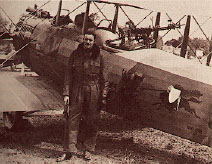|
History Notes Chapter 1, Page 1 of 2 World War I: The Birth of Aerial Observation |
||||||||||||||||
| As the United States came to grips with its commitment to provide troops to roll back the Germans in France, the 91st Aero Squadron, Aviation Section, Signal Corps, United States Army was born. The unit was officially activated at Kelly Field, Texas on August 20, 1917. It was soon shipped overseas and was one of the first five American flying squadrons to arrive in France. The 91st immediately began training in earnest and was attached to the First Army Group of the American Expeditionary Forces (AEF). | ||||||||||||||||
 |
||||||||||||||||
|
in the U.S. to see action in great numbers during WW I. (1) |
||||||||||||||||
| The 91st distinguished itself flying observation missions with DH-2 (Salmson 2A2), Breguet 14, DH-4 and Spad XIII aircraft during the time it spent fighting the Germans in World War I and later as a part of the U.S. occupation forces that remained in Germany until 1919. Working in conjunction with the First US Army Group, the 91st flew observation flights in support of campaigns of Lorraine, St. Mihiel, and the Meuse-Argonne. | ||||||||||||||||
 |
||||||||||||||||
|
|
||||||||||||||||
|
Right: Major Reynolds, Pilot and Chief Observer. (3) |
||||||||||||||||
 |
||||||||||||||||
 |
||||||||||||||||
| The 91st had its first big test during the battle to pinch off the German salient at St.-Mihiel. The Germans had been entrenched in their positions for years and trench warfare, thus far, had failed to budge them. Unfortunately, when the campaign began, the weather was so bad that most air missions on the opening day were limited to single-plane observation flights. General Mitchell took it upon himself to fly daily observation flights to get a better idea where he could best apply his air forces. As the campaign progressed the 91st was able to fly more frequent missions. While 91st Squadron pilots were flying over the battlefield trying to provide General “Blackjack” Pershing much needed intelligence, other famous military leaders, such as Colonel Douglas MacArthur and Colonel George Patton, were fighting below. |
||||||||||||||||
 |
||||||||||||||||
|
|
||||||||||||||||
| The primary purpose of the 91st Squadron was to gather information and immediately return to base to report it, not to fly over the battlefield looking for planes to shoot down (or get shot at themselves). obviously, the unit’s success can not be measured by number of aircraft shot down or total hours flown. Yet, over the course of its observation missions, the squadron did engage in 139 aerial combats and brought down 231 enemy planes during the over 1,000 hours it flew behind enemy lines. | ||||||||||||||||
 |
||||||||||||||||
|
|
||||||||||||||||
|
91st Squadron Air Crew on their way to work 1918 |
||||||||||||||||
 |
||||||||||||||||
|
Attributions: 1. The U.S. Air Service in World War I, Volume 3: The Battle of St. Mihiel, Maurer Maurer, The Albert F. Simpson Historical Research Center, Maxwell AFB, Alabama, 1978, page 482. 2.The U.S. Air Service in World War I, Volume 1: The Final Tactical Report, Maurer Maurer, The Albert F. Simpson Historical Research Center, Maxwell AFB, Alabama, 1978, page 261. 3. Maurer Maurer, page 99. 4. Blood April...Black September, Norman Franks, Russell Guest and Frank Bailey, Grub Street, The Basement, London England, 1995, page 90. 5. Maurer Maurer, page 277. |
||||||||||||||||
|
End of Page 1 of 2, Chapter 1 go to Page 2 Cover — Table of Contents — Introduction Chapters — 1 — 2 — 3 — 4 — 5 — 6 — 7 |
||||||||||||||||